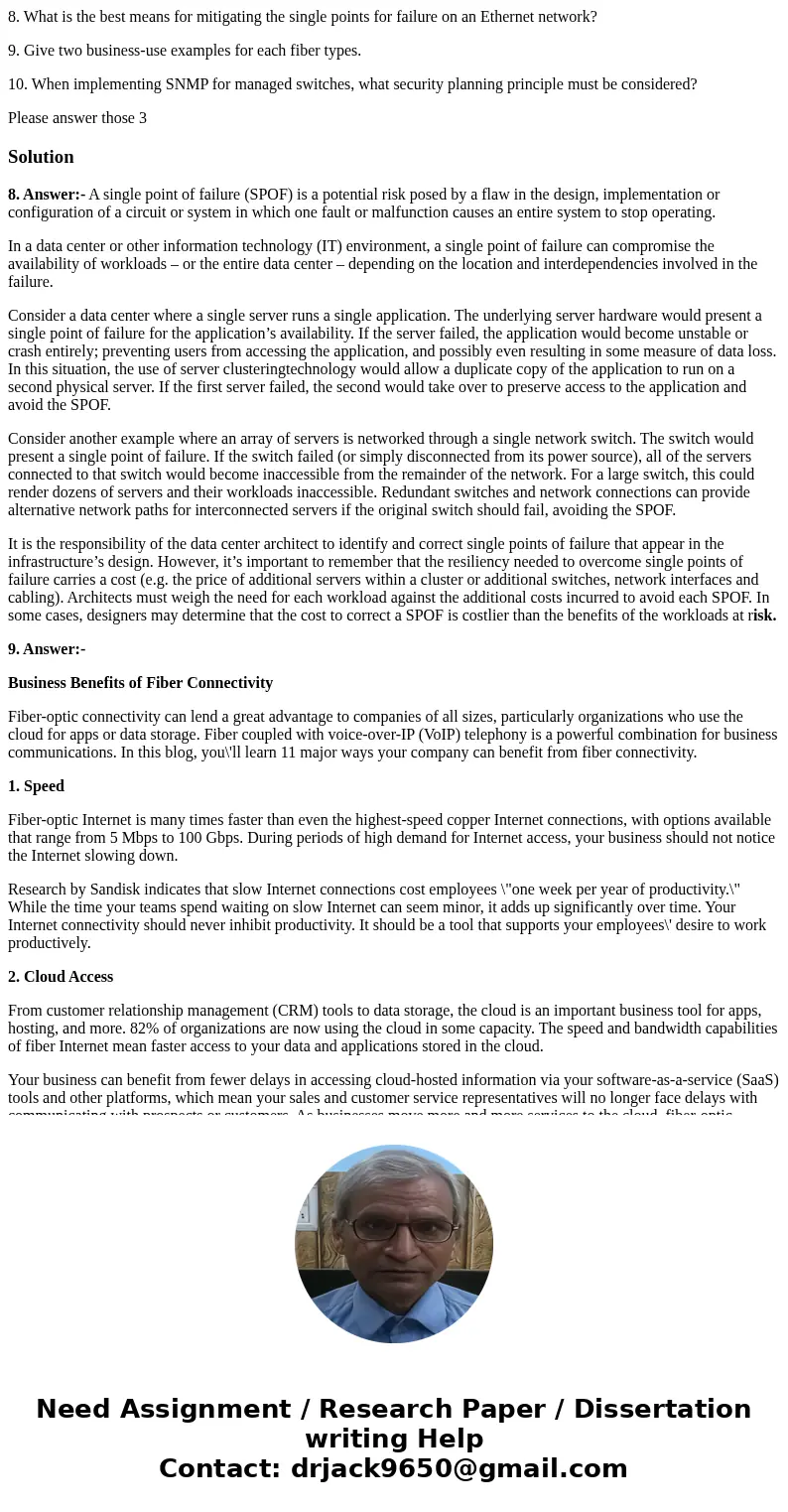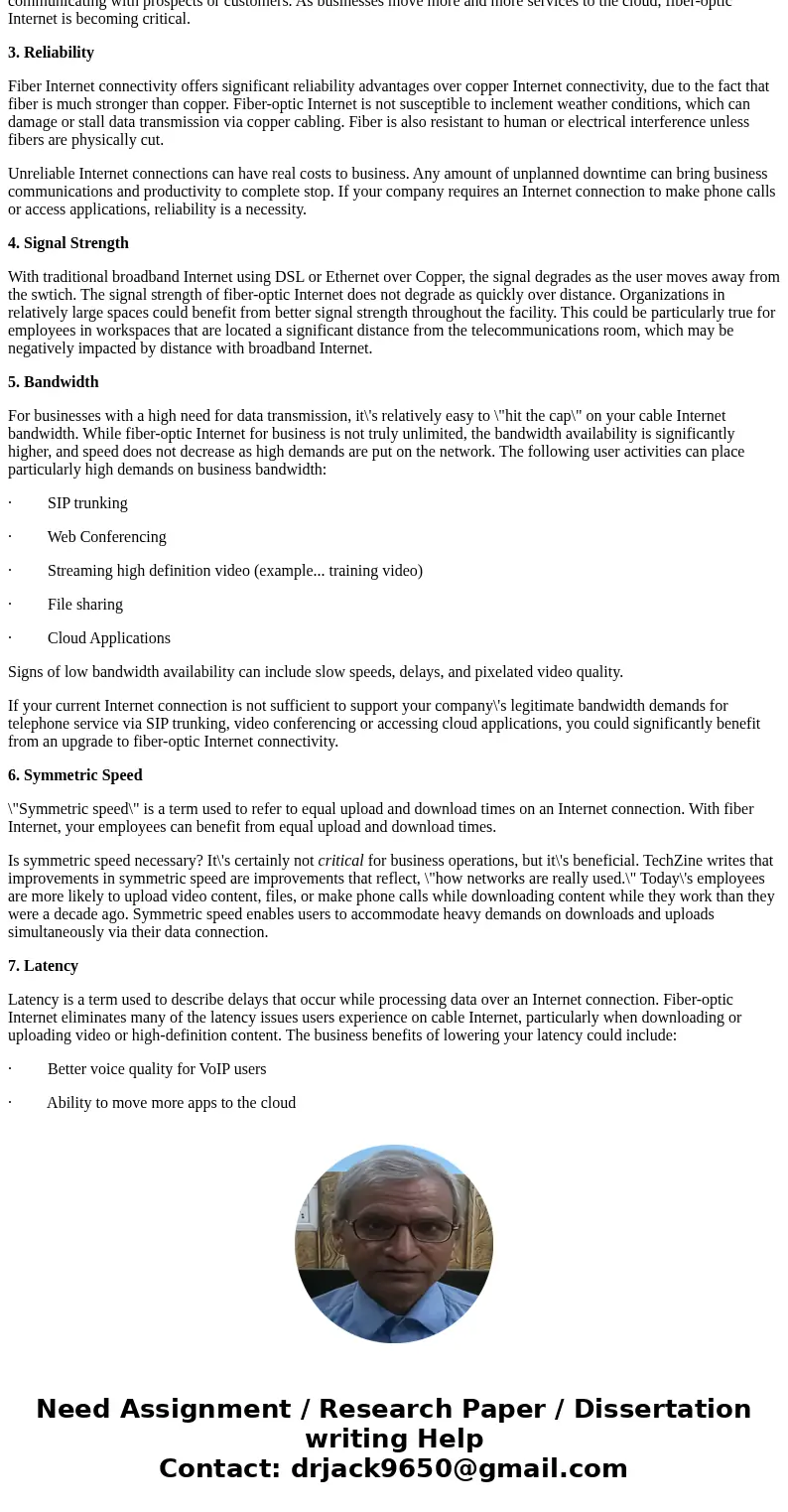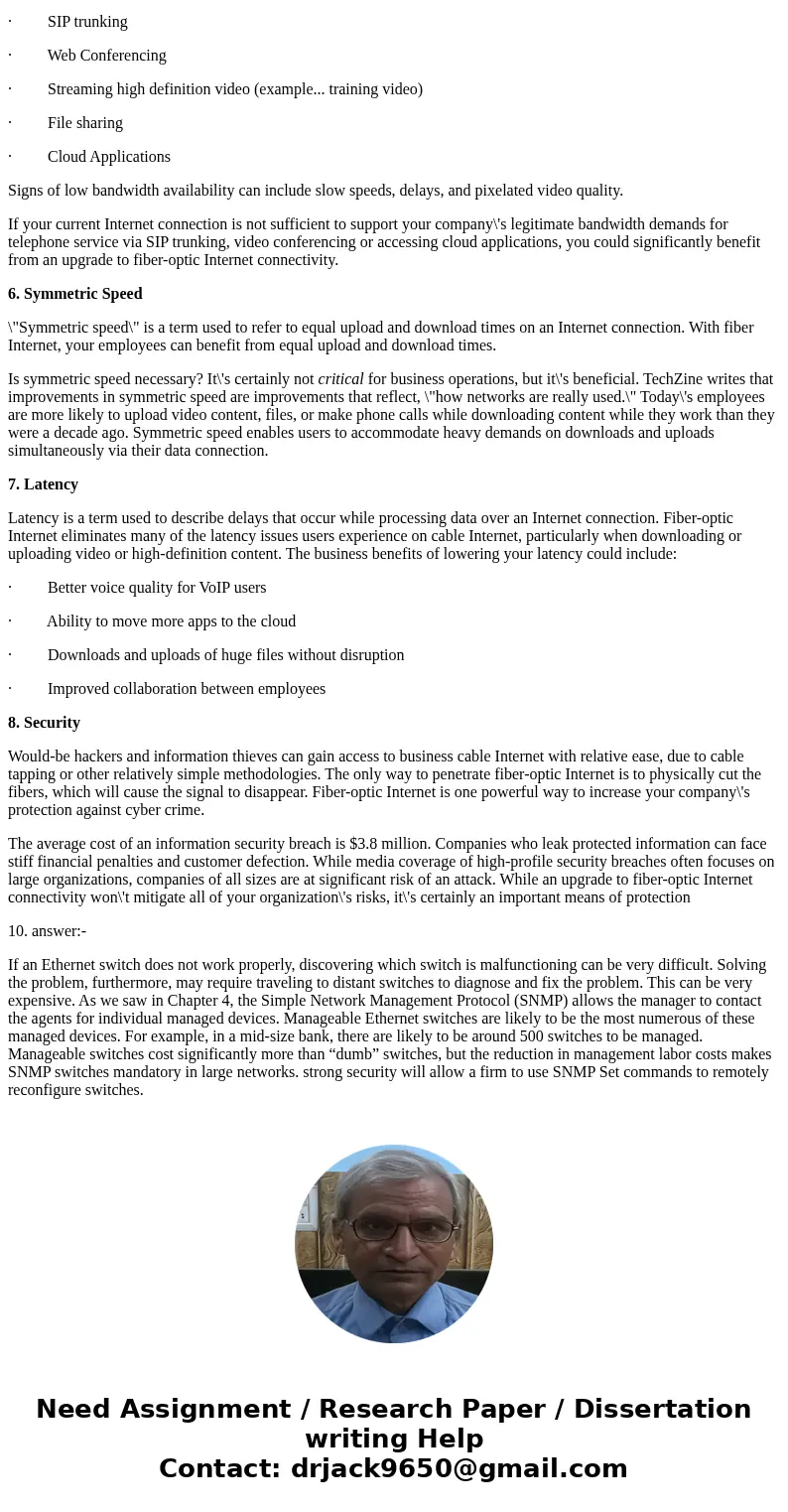8 What is the best means for mitigating the single points fo
8. What is the best means for mitigating the single points for failure on an Ethernet network?
9. Give two business-use examples for each fiber types.
10. When implementing SNMP for managed switches, what security planning principle must be considered?
Please answer those 3
Solution
8. Answer:- A single point of failure (SPOF) is a potential risk posed by a flaw in the design, implementation or configuration of a circuit or system in which one fault or malfunction causes an entire system to stop operating.
In a data center or other information technology (IT) environment, a single point of failure can compromise the availability of workloads – or the entire data center – depending on the location and interdependencies involved in the failure.
Consider a data center where a single server runs a single application. The underlying server hardware would present a single point of failure for the application’s availability. If the server failed, the application would become unstable or crash entirely; preventing users from accessing the application, and possibly even resulting in some measure of data loss. In this situation, the use of server clusteringtechnology would allow a duplicate copy of the application to run on a second physical server. If the first server failed, the second would take over to preserve access to the application and avoid the SPOF.
Consider another example where an array of servers is networked through a single network switch. The switch would present a single point of failure. If the switch failed (or simply disconnected from its power source), all of the servers connected to that switch would become inaccessible from the remainder of the network. For a large switch, this could render dozens of servers and their workloads inaccessible. Redundant switches and network connections can provide alternative network paths for interconnected servers if the original switch should fail, avoiding the SPOF.
It is the responsibility of the data center architect to identify and correct single points of failure that appear in the infrastructure’s design. However, it’s important to remember that the resiliency needed to overcome single points of failure carries a cost (e.g. the price of additional servers within a cluster or additional switches, network interfaces and cabling). Architects must weigh the need for each workload against the additional costs incurred to avoid each SPOF. In some cases, designers may determine that the cost to correct a SPOF is costlier than the benefits of the workloads at risk.
9. Answer:-
Business Benefits of Fiber Connectivity
Fiber-optic connectivity can lend a great advantage to companies of all sizes, particularly organizations who use the cloud for apps or data storage. Fiber coupled with voice-over-IP (VoIP) telephony is a powerful combination for business communications. In this blog, you\'ll learn 11 major ways your company can benefit from fiber connectivity.
1. Speed
Fiber-optic Internet is many times faster than even the highest-speed copper Internet connections, with options available that range from 5 Mbps to 100 Gbps. During periods of high demand for Internet access, your business should not notice the Internet slowing down.
Research by Sandisk indicates that slow Internet connections cost employees \"one week per year of productivity.\" While the time your teams spend waiting on slow Internet can seem minor, it adds up significantly over time. Your Internet connectivity should never inhibit productivity. It should be a tool that supports your employees\' desire to work productively.
2. Cloud Access
From customer relationship management (CRM) tools to data storage, the cloud is an important business tool for apps, hosting, and more. 82% of organizations are now using the cloud in some capacity. The speed and bandwidth capabilities of fiber Internet mean faster access to your data and applications stored in the cloud.
Your business can benefit from fewer delays in accessing cloud-hosted information via your software-as-a-service (SaaS) tools and other platforms, which mean your sales and customer service representatives will no longer face delays with communicating with prospects or customers. As businesses move more and more services to the cloud, fiber-optic Internet is becoming critical.
3. Reliability
Fiber Internet connectivity offers significant reliability advantages over copper Internet connectivity, due to the fact that fiber is much stronger than copper. Fiber-optic Internet is not susceptible to inclement weather conditions, which can damage or stall data transmission via copper cabling. Fiber is also resistant to human or electrical interference unless fibers are physically cut.
Unreliable Internet connections can have real costs to business. Any amount of unplanned downtime can bring business communications and productivity to complete stop. If your company requires an Internet connection to make phone calls or access applications, reliability is a necessity.
4. Signal Strength
With traditional broadband Internet using DSL or Ethernet over Copper, the signal degrades as the user moves away from the swtich. The signal strength of fiber-optic Internet does not degrade as quickly over distance. Organizations in relatively large spaces could benefit from better signal strength throughout the facility. This could be particularly true for employees in workspaces that are located a significant distance from the telecommunications room, which may be negatively impacted by distance with broadband Internet.
5. Bandwidth
For businesses with a high need for data transmission, it\'s relatively easy to \"hit the cap\" on your cable Internet bandwidth. While fiber-optic Internet for business is not truly unlimited, the bandwidth availability is significantly higher, and speed does not decrease as high demands are put on the network. The following user activities can place particularly high demands on business bandwidth:
· SIP trunking
· Web Conferencing
· Streaming high definition video (example... training video)
· File sharing
· Cloud Applications
Signs of low bandwidth availability can include slow speeds, delays, and pixelated video quality.
If your current Internet connection is not sufficient to support your company\'s legitimate bandwidth demands for telephone service via SIP trunking, video conferencing or accessing cloud applications, you could significantly benefit from an upgrade to fiber-optic Internet connectivity.
6. Symmetric Speed
\"Symmetric speed\" is a term used to refer to equal upload and download times on an Internet connection. With fiber Internet, your employees can benefit from equal upload and download times.
Is symmetric speed necessary? It\'s certainly not critical for business operations, but it\'s beneficial. TechZine writes that improvements in symmetric speed are improvements that reflect, \"how networks are really used.\" Today\'s employees are more likely to upload video content, files, or make phone calls while downloading content while they work than they were a decade ago. Symmetric speed enables users to accommodate heavy demands on downloads and uploads simultaneously via their data connection.
7. Latency
Latency is a term used to describe delays that occur while processing data over an Internet connection. Fiber-optic Internet eliminates many of the latency issues users experience on cable Internet, particularly when downloading or uploading video or high-definition content. The business benefits of lowering your latency could include:
· Better voice quality for VoIP users
· Ability to move more apps to the cloud
· Downloads and uploads of huge files without disruption
· Improved collaboration between employees
8. Security
Would-be hackers and information thieves can gain access to business cable Internet with relative ease, due to cable tapping or other relatively simple methodologies. The only way to penetrate fiber-optic Internet is to physically cut the fibers, which will cause the signal to disappear. Fiber-optic Internet is one powerful way to increase your company\'s protection against cyber crime.
The average cost of an information security breach is $3.8 million. Companies who leak protected information can face stiff financial penalties and customer defection. While media coverage of high-profile security breaches often focuses on large organizations, companies of all sizes are at significant risk of an attack. While an upgrade to fiber-optic Internet connectivity won\'t mitigate all of your organization\'s risks, it\'s certainly an important means of protection
10. answer:-
If an Ethernet switch does not work properly, discovering which switch is malfunctioning can be very difficult. Solving the problem, furthermore, may require traveling to distant switches to diagnose and fix the problem. This can be very expensive. As we saw in Chapter 4, the Simple Network Management Protocol (SNMP) allows the manager to contact the agents for individual managed devices. Manageable Ethernet switches are likely to be the most numerous of these managed devices. For example, in a mid-size bank, there are likely to be around 500 switches to be managed. Manageable switches cost significantly more than “dumb” switches, but the reduction in management labor costs makes SNMP switches mandatory in large networks. strong security will allow a firm to use SNMP Set commands to remotely reconfigure switches.



 Homework Sourse
Homework Sourse